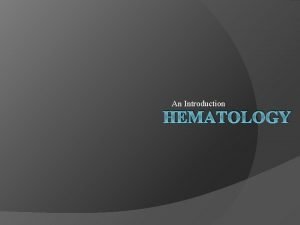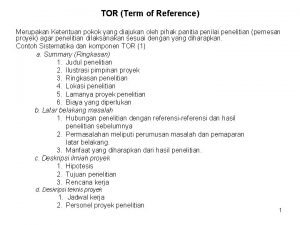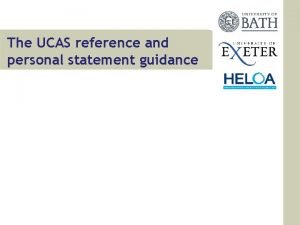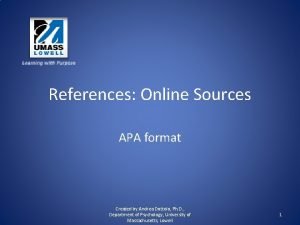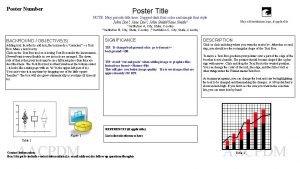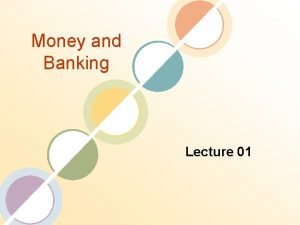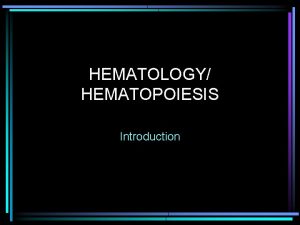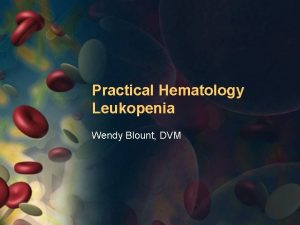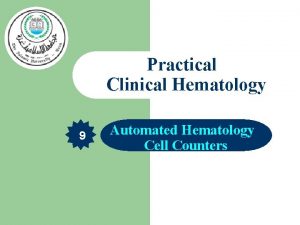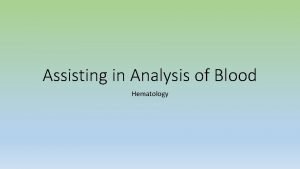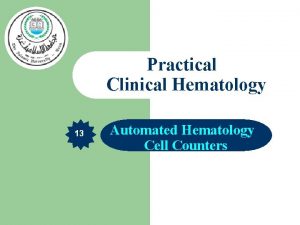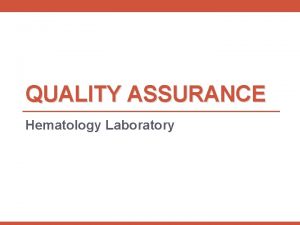An Introduction HEMATOLOGY HEMATOLOGY 1 a Without references













- Slides: 13

An Introduction HEMATOLOGY

HEMATOLOGY 1 a. Without references identify basic facts and terms about hematology with a minimum of 70% accuracy. (1) Hematology (2) Circulatory System (3) Origins of Blood Cells (4) Hematological Diseases (5) Specimens for Hematology

HEMATOLOGY Branch of medicine that studies blood cells and blood-forming tissue Includes hemostasis (the process of stopping bleeding) Tests can detect diseases such as Anemia Leukemia Hemophilia

Circulatory System Circulation Blood circulates from the heart to the lungs to pick up O 2 Oxygenated blood returns to the heart to be pumped out to the tissues O 2 is exchanged for CO 2 in the tissues Blood returns to the heart and lungs to release the CO 2 by exhaling http: //www. youtube. com/watch? v=AB


Types of Vessels Arteries- Carry blood with O 2 (excluding pulmonary artery) Veins- Carry blood with CO 2 (except for pulmonary vein) Capillaries- Smallest blood vessel (point of gas exchange

Composition of Blood Volume - approximately 5 liters in an adult Components (mostly water) Plasma – 50 -60% of blood volume; mostly H 2 O with proteins, carbohydrates, lipids, hormones and antibodies X 5

Cellular Elements Erythrocytes (RBCs) major function - transport O 2 and CO 2 life span - 120 days Leukocytes (WBCs) major function - provide immunity and defense against infection, (5 types)

Cellular Elements Thrombocytes (platelets) major function – hemostasis life span - 10 days

Origins of Blood Cells Hemopoiesis - formation and development of blood cells Liver (fetus) Bone marrow (adults) – blood cells mature in marrow and are released into circulation

Hematological Diseases Leukemia – overproduction of WBCs Anemia – decreased number of RBCs Thrombocytopenia – decreased number of platelets Polycythemia – increased number of all types of blood cells Inherited diseases – hemophilia and sickle cell

Specimens for Hematology Capillary and venous blood used Complete Blood Count Specimen of choice – whole blood with EDTA anticoagulant Coagulation testing Specimen of choice – whole blood with sodium citrate anticoagulant

HEMATOLOGY 1 a. Without references identify basic facts and terms about hematology with a minimum of 70% accuracy. (1) Hematology (2) Circulatory System (3) Origins of Blood Cells (4) Hematological Diseases (5) Specimens for Hematology
 Introduction of hematology
Introduction of hematology Without title poem pdf
Without title poem pdf Without title poem by diane glancy
Without title poem by diane glancy Justify the title of keeping quiet
Justify the title of keeping quiet Objectives in a cv
Objectives in a cv Apa itu terms of reference
Apa itu terms of reference Ucas reference
Ucas reference Risk management reference list
Risk management reference list References apa format
References apa format How to put references on a poster
How to put references on a poster Five core principles of money and banking
Five core principles of money and banking Difference between bibliography and references
Difference between bibliography and references Intertextual reference
Intertextual reference Unclear pronoun reference
Unclear pronoun reference
